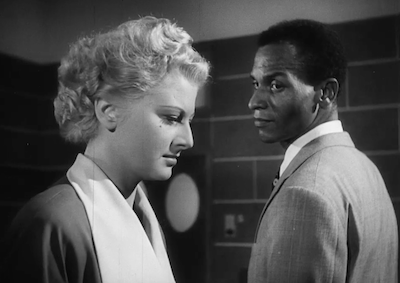Watch on Vimeo until August 6
Anna’s Sin
Il peccato di Anna
Italy, 1952
A unique film for its time, Anna’s Sin is an adaptation of William Shakespeare’s Othello set in Rome of the early 1950s. In particular, Anna’s Sin stages an interracial relationship at the moment of the rise of the U.S. civil rights movement, Pan-Africanism and anti-colonial struggle. Originally debuting in Italy in 1952, Anna’s Sin was released in the U.S. in 1954 and later re-released in 1961 as an interracial exploitation film. For many years, Anna’s Sin was an out-of-circulation, “lost” film, with The Wisconsin Historical Society Archives in Madison, Wisconsin holding a rare English-dubbed version. In 2017, the UCLA Film & Television Archives digitized a 35mm print of the film held by the Wisconsin Center for Film and Theater Research and are pleased to organize a virtual screening of this rarely seen work.
Anna’s Sin offers a glimpse of Italy of the 1950s, then in the early period of its postwar “economic boom.” After the devastation of World War II, Italy, with assistance from the U.S. Marshall Plan, entered a period of enormous and rapid economic recovery. The Italy shown in the film is distinct from its representation in neorealist films of the period. Rather than a destitute country struggling with poverty and devastation, Anna’s Sin displays a vibrant Italian youth culture, influenced by American popular culture, and particularly by jazz music. In Anna’s Sin, Italy is also a site of African American expatriatism as exemplified by novelist and screenwriter William Demby and translator Ben Johnson’s roles.
The film was written and produced by its lead actor Anna Vita, an Italian star of fotoromanzos (photo romance novels). Vita conceived Anna’s Sin as a starring vehicle for Canada Lee (Cry, the Beloved Country, 1951), after meeting the actor and activist. Following Lee’s untimely death in 1952 prior to production, Ben Johnson took up the lead role of John Ruthford, an African American Shakespearean actor who arrives in Rome to stage Othello; Vita performs the title role of Anna Curti, who Ruthford casts as Desdemona. Ruthford’s character is a reference to performer and activist Paul Robeson, who in 1930 became the first African American to perform Othello in London since the 19th century. The story follows John and Anna’s burgeoning romance as they stage Othello, with key scenes from the play appearing within the film. Their relationship is threatened by Anna’s scheming guardian, Alberto (Paul Muller), who wishes to marry Anna for her inheritance. The narrative is also complicated by Ruthford’s hidden past, one tied to Sam Hudson (William Demby), an expatriate who holds the key to Ruthford’s freedom.
In the realm of Othello film adaptations, Anna’s Sin is contemporaneous with Orson Welles’ The Tragedy of Othello, The Moor of Venice (1951), in which Welles performs the lead, perpetuating a long tradition of white actors performing the role in blackface. Not only is Anna’s Sin notable for its progressive racial politics, it eschews and critiques blackface performance through the casting of a Black American actor as Othello. As demonstrated in an Ebony feature interview of the period, Vita wrote Anna’s Sin with the intent of making a political comment upon the times, stating, “I wanted to say something for the Negro and against prejudice.” Ultimately, Anna’s Sin speaks to mid-20th century transnational circuits of civil rights activism, an expanse that included Hollywood and Rome’s “Hollywood on the Tiber."
Post-screening conversation with UCLA School of Theater, Film and Television Associate Professor Shelleen Greene and researcher Melanie Masterton Sherazi, Ph.D.
Film note co-authored by Greene and Sherazi.
B&w, 86 min. Director: Camillo Mastrocinque. Writers: Edoardo Anton, Camillo Mastrocinque, Anna Vita. With: Anna Vita, Ben Johnson, William Demby.
Digitally scanned by the UCLA Film & Television Archive from an English-dubbed 35mm print from the Wisconsin Center for Film and Theater Research.






 Mobile Navigation
Mobile Navigation

